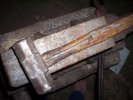I've had problems with the wrist of my hammering arm before. A prominent bladesmith told me to always stretch before and after forging. Stretch one arm straight out in front of you with the fingers pointing up to the sky like you are telling someone to stop. With your other hand gently pull back on the fingers of the extended hand.
Then make the extended hand point to the ground, that is by just flipping your hand from the "stop" position downward. Using your other hand fold the thumb of the extended hand to your palm and cup the fingers toward your wrist gently pulling the hand toward you.
I stress the word gently! Do them multiple times for each arm. The hand holding the tongs can develop problems too from the constant squeezing tension. These stretches seem to have solved most of my problems though I did have to lay off forging for a while also.
As stated before in this thread already I also think it is a bad idea to have your thumb on top of the hammer so avoid that.
Do these stretches anytime but especially before beginning to forge. When doing these stretches you should feel the motions in the tendons on the bottom and top of your forearm from your wrist all the way to the elbow.
If all else fails let me tell you about Tom Clark. He is a blacksmith extroadinaire and thought he was going to have to retire from smithing due to injuries. By using a new technique however and Uri Hofi designed hammer he has a new lease on forging and is stronger than ever. I'll try to describe this method though I haven't tried it myself, mainly because it works best with a hammer, like the Hofi (which is also very expensive by the way), that has most of it's mass centered where the handle meets the head. The handle is shortened, like most hammer handles should be anyway, and gripped not far from the head in a loose pinch between the thumb and first finger of the hand! With your elbows tucked in to your side the hammer is raised stright up. At the highest point the butt of the hammer handle is allowed to rotate upwards. On the downstroke the hammer head rotates downward and the face meets work. The rotation imparts great speed to the stroke and since force is a function of speed as well as mass, the blow has geat force without having to "muscle" force into your hammering. I may not have described this method well, but if you have watched him demo you will be a believer. The handle has to be rather short with this method because
Here is a link to a little information on him with a picture:
http://www.altuit.com/webs/altuit2/Blacksmith/WhoWhatWhere.htm
He's a tough wirey little dude but can do more work smithing than men twice his size!

